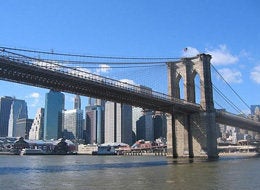
It's been a while, but as I wrote in April when I was in New Orleans for the annual conference of the American Planning Association, I found two themes resonating through the conference: "sustainable urbanism," which I discussed in my last article for Huff Post, and "what to do with the suburbs."
If reversing the decline of cities was the preoccupation of planners in the 20th century, then the suburbs are going to be the focus of planning for much of this one. We can only hope that the planners come up with better solutions for the suburbs than all those that didn't work for cities.
Perhaps that's too harsh. As planners at the Department of Housing and Urban Development tried to fix cities, every other department of government, at all levels, was facilitating sprawl. Public investments, tax policy, and zoning all favored investment wherever the fringe was. Dispersal of jobs and commercial activity, not to mention the building of new schools and other public infrastructure, convinced nearly all that living in a single-family home, on a cul-de-sac that one could only drive to, with a mortgage to pay and a yard to mow, and with an extra car or two to pay for, was the only way to live.
And what could any "urban" program based on the design of places and the building of buildings do about the nightmarish problems that resulted from isolating poor people, many of whom were historically discriminated against minorities from rural areas who were unfamiliar with urban life, in declining neighborhoods of cities hemorrhaging jobs?
But to return to the present, the suburbs and their next iterations have everyone's attention. The APA conference had many sessions with titles like "How to Fix your Suburban Downtown," or "From Boomburg to Build Out," or "Reshaping Suburbs as Walkable Urban Places."
The topic garners so much attention because although there is an overall preference among planners for the cities to revive, and hopes that that will happen, it's impossible to expect that the considerable population growth America will experience in the 21st century can be accommodated in existing cities.
For instance, at the conference I attended a panel on the history and future of the "Great American Suburb" where architect and planner David Dixon, co-author of the 2009 book, Urban Design for an Urban Century: Placemaking for People, pointed out that to accommodate predicted population growth from now until 2030, 150 billion square feet of development would be built. This growth will not and cannot all take place in revitalized cities.
There's also the sense that the suburbs, or at least the so-called "inner-ring suburbs", are at a social tipping point. A recent Brookings Institute study found that it's now the suburbs, rather than the cities, that are more likely to be home to minorities, the poor and the elderly. (This makes inevitable sense when you consider that nearly all growth over 60 years has taken place in the suburbs -- the suburbs are where people are.)
The issues facing 21st century planners will be how to deal with population growth while avoiding more sprawl at the edges, and how to prevent more decades marked by (i) disinvestment in cities and older suburbs and (ii) isolation of the disadvantaged (who may well include a huge mass of elderly Baby Boomers). The consensus among planners is that to solve these problems there need to be strategies for allowing and encouraging existing suburbs to evolve into denser versions of themselves, with more of the good qualities of cities and towns.
One problem with this is that the zoning in suburbs is rigid and politically difficult to change. The culture celebrating the single-family house is so strong that people don't like to convert their single-family neighborhoods into something else, even as demographics change. For instance, in November 2009 the U.S. Environmental Protection Agency published a guidebook called "Essential Smart Growth Fixes for Urban and Suburban Zoning Codes", with suggestions based on a panel the E.P.A. had convened in 2008. But nearly all of the suggested fixes would only affect the zoning on un-built land or in commercial zones -- the book has no concrete suggestions about what to do with existing single-family home districts.
This political reality puts the densification focus on existing commercial zones, such as malls or office parks or, where they exist, in the vestigial centers of small towns that existed prior to being engulfed by sprawl.
Two current strategies to do this are "de-malling", i.e., turning existing (often enclosed) malls into "town centers" by opening them up and adding housing and/or offices, and creating the equivalent of high-density urban downtown job centers in the suburbs, ideally connected to the regional center (the historic downtown) by rapid transit.
Perhaps the greatest example of the latter phenomenon is Tyson's Corner, in Fairfax County, Virginia. At the APA conference I heard James P. Zook, the head of planning in Fairfax, describe some of the changes coming there. According to Mr. Zook, at present Tyson's Corner qualifies as the 12th largest "central business district" in the U.S. with more office space than Atlanta, and coming densification will nearly double the number of jobs there to 200,000. More important, however, the plans are to increase the number of residents more than five-fold, to 100,000, and Mr. Zook said that future development would establish and take place on a more traditional urban street grid.
In a future column I'll look into the politics of all this "suburbanism."
Frank Gruber writes a weekly column on local politics, which often involve land use issues, for the Santa Monica Lookout News, a news website. His first book, Urban Worrier: Making Politics Personal, was published last year by City Image Press.